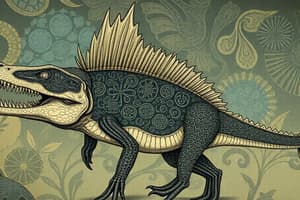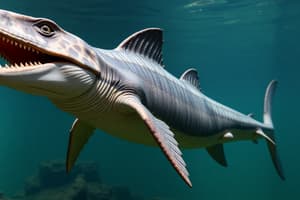Podcast
Questions and Answers
What did the paleontologists propose about the ichthyosaurs at the Berlin-Ichthyosaur site?
What did the paleontologists propose about the ichthyosaurs at the Berlin-Ichthyosaur site?
- They died during a toxic algal bloom.
- They were coming to give birth. (correct)
- They were hunting and feeding there
- They were engaging in cannibalism.
What technique did Pyenson and colleagues use to study the Berlin-Ichthyosaur site?
What technique did Pyenson and colleagues use to study the Berlin-Ichthyosaur site?
- Examining museum specimens
- Digging trenches
- Creating a digital dataset (correct)
- Analyzing fossilized remains
What is one of the marine reptiles found at the Berlin-Ichthyosaur site?
What is one of the marine reptiles found at the Berlin-Ichthyosaur site?
- Plesiosaur
- Mosasaur
- Shonisaurus (correct)
- Ichthyosaur
What does the lack of evidence of cannibalism suggest about the marine reptiles?
What does the lack of evidence of cannibalism suggest about the marine reptiles?
What is unclear about the Berlin-Ichthyosaur site?
What is unclear about the Berlin-Ichthyosaur site?
Flashcards are hidden until you start studying
Study Notes
- ichthyosaurs, a group of marine reptiles, were found bunched together in the middle of the Nevada desert.
- The paleontologists propose a new interpretation of this site, which is that the ichthyosaurs were coming to give birth.
- The new research is an extension of what Pyenson and other researchers have studied at places like Cerro Ballena in Chile's Atacama Desert.
- There, paleontologists have found dozens of skeletons of prehistoric whales and other marine mammals that appear to have died during toxic algal blooms and washed onto a tidal flat.
- Pyenson and colleagues wanted to see if something similar had happened at Berlin-Ichthyosaur and applied some of the same research techniques.
- The multiyear effort created a digital data set of the site that allowed for a broader analysis than simply looking at museum specimens.
- "It's a really fascinating site, and it's exciting to see new research being focused on this important ichthyosaur graveyard," says University of Manchester paleontologist Dean Lomax.
- The Berlin-Ichthyosaur site has yielded the remains of many large, predatory marine reptiles, including Shonisaurus.
- The site lacks evidence of cannibalism, which suggests that the marine reptiles hunted and fed elsewhere and deposited their babies in the warm, relatively predator-free waters of what eventually became Berlin-Ichthyosaur.
- The paleontologists propose that Shonisaurus did their hunting and feeding elsewhere and deposited their babies in the warm, relatively predator-free waters of what eventually became Berlin-Ichthyosaur.
- If the paleontologists’ migratory hypothesis is correct, then Shonisaurus returned to the same area time and again to give birth over during a span of more than 100,000 years.
- Precisely why so many Shonisaurus perished and were buried in this relatively small geographic area is unclear.
Studying That Suits You
Use AI to generate personalized quizzes and flashcards to suit your learning preferences.





